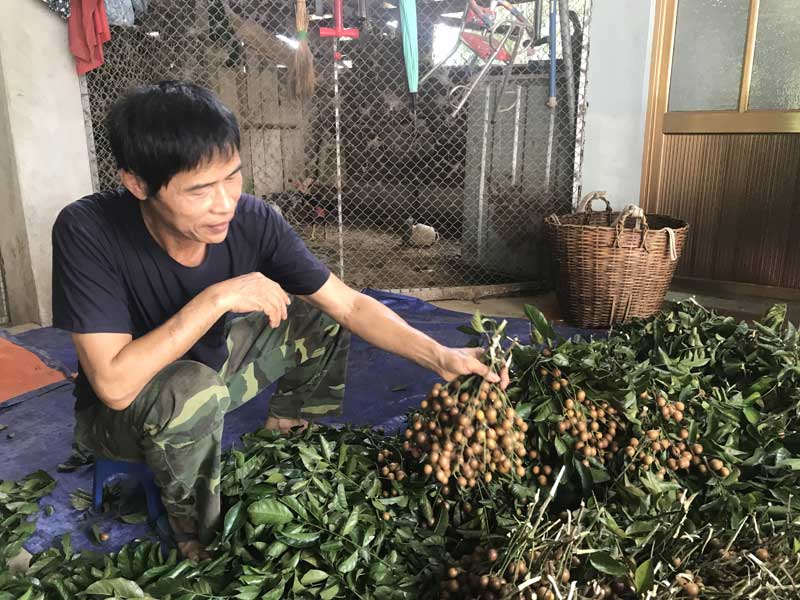
(HBO) - The middle of June is the time when people in Dong Giang hamlet, Mong Hoa commune (Hoa Binh city) harvest clausena lansium. The harvesting time is just over one month. Every day, cars and motorbikes of businessmen flock in and out in Dong Giang. Along Highway 6 in Mong Hoa commune there are a lot of sellers and buyers.

Dong Giang clausena lansium.
With
more than 60 clausena lansium, up to this time, Mr. Bui Van Hung's family in
Dong Giang hamlet, Mong Hoa commune (Hoa Binh city) has harvested over one ton
of fruit with an income of nearly 30 million VND.
In
Dong Giang, there are clausena lansium trees which are hundreds of years old.
The local people do not know when they have been, either. In the neighborhood,
every household has at least fifteen trees, there are households growing as
many as 50 to 60 trees, and even many households have more than 100 trees. For
a long time, clausena lansium in Dong Giang has become a specialty of tourists
near and far. Indeed, the bunches of dark brown clausena lansium with small and
beautiful fruits are not only delicious in the summer that are popular with
many people, but they are also the valuable medicinal herbs being handed down
for a long time.
This
summer, due to the prolonged strong sunlight with less rain, the quality and
output decreased compared to the previous crop, clausena lansium in Dong Giang
continues to bring the economic benefits to the households. 40 -50 kilos have
been harvested from the small trees, the average trees have given from 100-150
kg. The selling price is from 20,000-25,000 VND a kilo.
The
head of Dong Giang hamlet, Mr. Nguyen Ngoc Tuan added that along with the rice
cultivation, the economic development of forests, clausena lansium has been
identified as a key crop in the village. Thereby, the per capita income
currently reaches 36 million VND a year. The rate of the poor households has
decreased to 3%. In the long term, we want the appropriate authorities to
conduct surveys and researches to build the brand for Dong Giang, making this
special tree into OCOP product so that people can continue promoting the
movement of improving the mixed gardens and expanding the areas to improve the
living standards.
The Standing Board of the Hoa Binh provincial Party Committee has agreed in principle on a proposal by the Standing Board of the Party Committee of Hoa Binh city to gather feedback on the city’s 1:2000 zoning plan, which forms part of its broader urban development strategy.
Hoa Binh province has made notable progress in public administration reform and digital government development, with the satisfaction index among citizens and businesses reaching over 84%, according to recent government evaluations.
Thanks to great efforts by local authorities in recent times, the governance and public administration performance of Mai Chau district has been significantly improved.
In the afternoon of June 6, the Party Committee, the People's Council, the People's Committee and the Fatherland Front of Lac Son district solemnly held a meeting to celebrate the 139th anniversary of the district's founding (1886–2025) and the 79th anniversary of the establishment of the district's Party Committee (1946–2025). There was the attendance of Mr. Bui Van Thang, the Vice Chairman of the Provincial People's Council; Mr. Quach Tat Liem, the Vice Chairman of the Provincial People's Committee; Ms. Dang Bich Ngoc, the Deputy Head of the National Assembly Delegation of the province; as well as the former leaders of the province and district through various periods, who are the natives of the district.
Implementing the Politburo’s Resolution No. 57-NQ/TW on breakthroughs in science – technology, innovation, and digital transformation is a golden opportunity for the northern mountainous province of Hoa Binh to renew growth model, improve competitive edge and shorten digital gap.
Resolution 57-NQ/TW, issued by the Politburo on December 22, 2024, identifies sci-tech, innovation, and digital transformation as strategic breakthroughs to build a developed and prosperous nation. In Hoa Binh province, this spirit is not just a slogan, it’s being put into action through concrete initiatives that form a "new development triangle”: digital citizenship, digital economy, and digital administration.



